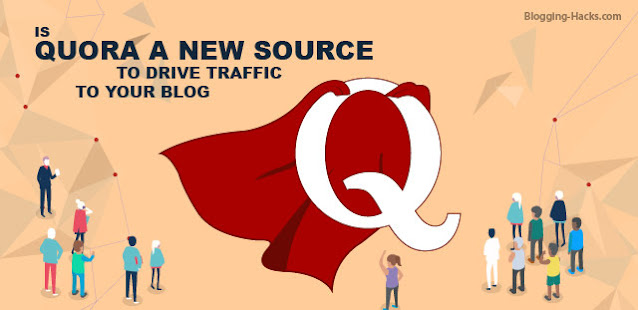
Quora is basically a question-answer site where a user can ask questions and get answers from other users. Most internet users must be acquainted with this website at least once. Within this post, we will explore how Quora could become a new source to drive traffic to your blog.
To understand how Quora is a crucial part of this strategic approach, observe Google search results for every query you make on Google. You will find at least one Quora link in the first 10 results. Realize the potential, the amount of traffic it could draw to your blog. Quora has a vast list of questions and answers to satisfy your quest for traffic.
You will find many users giving prolonged answers covering substantial information in their answer's write-up. This is nothing but the part of a strategic approach to drive traffic to their blog from Quora.
Is that so easy to drive traffic from Quora? No, it isn't. It takes a lot of precision in your opinion, proactiveness, authority on topics, and loads of patience. But then don't get disappointed. We are here to help each other, aren't we?
So, what does it takes to have that authority, proactiveness, and precision over the topic? We'll have to look at it step by step.
Quora has a tremendous amount of traffic, precisely over 300 million monthly unique visitors (2018 statistics), as stated by Ryan Browne, VP of Revenue at Quora.
Such massive traffic which is ever-growing and not utilized properly. Imagine if you could drive traffic even a thousand users to your blog. Quora traffic could give results in a lesser time span as compared to SEO and it is a sustainable source.
Let's have a look at the strategic approach to drive traffic from Quora.
1. The Authority - Setting up a profile
Why it is necessary to set up a profile? You could straight away write pleasant, lengthy answers and get to enjoy that traffic, isn't it? But it is necessary to set up your profile before you do so.
A well-written profile explains your reader who you are, what are your skills and expertise.
A profile picture, with your bio, and expertise could help you to establish authorship among your readers. Users could relate and will have reasons to trust you.
Additionally, you can include your blog link and social media links in your profile. Your reader might want you to follow you on social media too.
2. Choosing topics for your questions
The next step after creating a readers-ready profile is choosing a topic for your questions. There could be multiple topics for answering questions. The only factor you should consider while answering the questions is that you have to be 100% perfect.
Now, our ultimate goal is to drive traffic from Quora to your blog. Hence on Quora, we will stick with the topics that are related to our blog.
In my case, I can choose to answer questions that are related to starting a blog, monetizing options, free resources for blogging, SEO, and so on. You can choose topics that are related to your blog.
On a home of the Quora, you can edit and add topics relating to your niche in the left panel.
3. Finding the right questions
The most crucial part of this strategy is to find the right questions. Questions with a high number of answers and followers should be your prime destination.
Yet, you should avoid the most highly popular questions unless you have something extra to contribute which is not done by anyone else. Highly popular questions are already answered and these are extremely competitive. There is the least chance you could derive something from there.
The questions which are posted recently and not older than a week, questions with answers ranging from 20-50, and followers more than 20 should be your prime spot.
More the followers better will be the opportunity to get highlighted. Since when you post an answer on a question with the high number of followers, those many followers get notified.
4. Long answers over the short answers
Well, this is a bit tricky part and you will have to get the best of both worlds. Take care of a few small points here and you are sorted.
- Write well descriptive and long answers. However, your answer should not reveal everything, at the same time a reader should feel valued while reading your answer.
- Avoid using long paragraphs. Instead, break your answer in small chunks of lines, making a paragraph of not more than 4 lines.
- You can arrange your answer in points. Use formatting a little to make words bold, make a number list, or bullets to list out the points.
A user should have a pleasant experience while reading your answer. The user interface and everything else cannot be managed by the contributor. Though, formatting the answer could make a little difference.
5. Include pictures in your answers
You all know that a picture could convey a thousand words. Pictures grab the attention of the readers than normal textual answers. Hence for better impact use images in your answers.
Including infographics in your answers is a good idea. I often do that. Statistical and even categorical data can be converted into an infographic. This looks really amazing and catchy as compared to other plain answers.
However, any random pics won't add value in your post. You should be able to find relevant images or at least relate images being used in your answer to the story being conveyed.
6. A final step, adding links
Once you are done answering the question and happy with your writeup, the final step is to include a link to your blog post.
As discussed in point #4, we do not reveal complete information and keep some information on our blog for readers to follow. So that they find a need to click on the link and read the rest of the information on your blog.
Write a good call to action while placing a link in your answer. A reader should be convinced completely to follow the link and visit your blog.
There is another approach. You may give full information to the reader and place several links to your blog (don't spam with so many links, 4-5 links are fine) relevant to the topic of the question being asked.
An SEO technique could be applied here while adding links. You may use important keywords for the anchor text so that your keyword ranking, PA, and DA have a benefit out of it.
7. Review before you post
It's a good practice to review your write-up before you publish it online. Verify your answer for correctness, language, etc. See if you have covered all the points asked in the question.
Apart from that, you should correct spelling mistakes, ensure there are no missing words, and fix grammar mistakes if any.
Poorly written answers may create a bad impression and may convey a lack of seriousness. Your answer should have the highest level of precision.
Poorly written answers may create a bad impression and may convey a lack of seriousness. Your answer should have the highest level of precision.
8: Proactiveness and regularity
Once you are familiar with how Quora works, the next step is to apply that strategic approach proactively. Answering one or two questions wouldn't take you anywhere.
To get regular traffic from Quora in a greater number, you will have to answer more and more questions as possible. Your answers on Quora will definitely become a new source to drive traffic to your blog.
Proactiveness and regularity are the key factors that make this strategy practically successful.
Conclusion
There are a variety of options one could drive traffic to their blog. We have listed a few amazing traffic sources for a new blog in the post How to Get Traffic to Your New Blog. To me, Facebook and Google are the prime traffic sources and work well for my blog.
Quora has huge traffic, in millions per month. We can drive some of this traffic from Quora and get benefited. To do so we need authority, proactiveness, and precision in our answers.
We set up a profile to build the authorship and trust among users. Later we define our domain by selecting the right topics which are relevant to your blog.
Furthermore, we find questions that have the potential to drive traffic to your blog. We looked at writing descriptive answers and restraining an urge to follow your blog.
Including pictures in your answer may put life into a text-heavy answer. Adding contextual links in your answer would make the user follow the link.
Finally, before posting your answers on Quora, it should be checked for correctness. In order to work your Quora strategy effectively, you will have to work on it proactively and regularly.
Do not spam your answers with too many links or affiliate links. The ultimate motive should be to route Quora traffic to your blog in search of the information.
I always urge readers to comment on the blog post. As it encourages and helps me write more and more blog posts. Please let me know through comments if you liked this post. Give it a share on Facebook, Twitter, and LinkedIn.












1 comments
Thank you for sharing such a wonderful content. I am a blogger and I found all the information related to blogging in Blogging hacks and that’s helped me a lot..
ReplyDelete